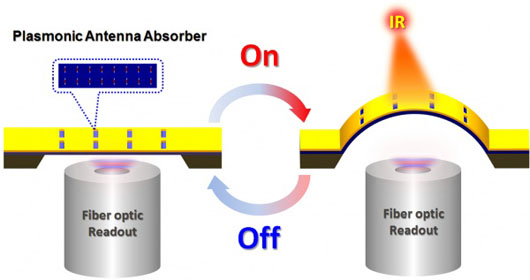Nanoantenna Based IR Sensors to Revolutionize Spectroscopy

A group of scientists at the University of Pennsylvania have developed a new way of converting infrared (IR) light to mechanical action by utilizing a pattern of nanoantennas. This new research makes it possible for developing more sensitive IR detectors for use in IR cameras and spectrometers.
The existing IR detectors use either cryogenically cooled semiconductors or thermal detectors to detect and correlate the changes in electrical resistance with changes in temperature. These are efficient techniques, but when it comes to applications like spectroscopy that require high sensitivity, the size and cost of the equipment employing these techniques increase drastically to meet the requirements.
Engineers from the University’s Department of Material Science and School of Engineering and Applied Science have developed an optomechanical thermal infrared detector that correlates the change in temperature with mechanical changes instead of changes in resistance in correlation with temperature.
The device has a nanoscale structure measuring about 0.1mm in width and 0.5mm in length with its core made of gold bonded to a silicon nitride layer. Both the materials have different thermal expansion coefficients and when they come in contact with IR light, they absorb the heat and expand depending upon their thermal expansion coefficients.
Gold has a higher thermal expansion coefficient than silicon nitride and as both the layers are attached together, the gold layer can’t expand linearly hence it expands into the third dimension. A fiber interferometer is used to determine how far the structure has bent upwards due to the expansion of gold layer, thus enabling researchers to see displacements that are thousands of times smaller than a hydrogen atom.
This device is more sensitive than others developed using the same principle because of the inclusion of “slot” nanoantennas, cavities etched into the gold layer at intervals corresponding to mid-IR wavelengths to concentrate IR radiations into the slots. This increases the conversion efficiency of the detector. The device’s sensitivity to the type of light can be decided by the pattern on slots etched on its surface.
The research is currently at the proof-of-concept stage and further work is being carried out to demonstrate the device capabilities as a low cost way of analyzing individual proteins and gas molecules.
Source: Penn News

